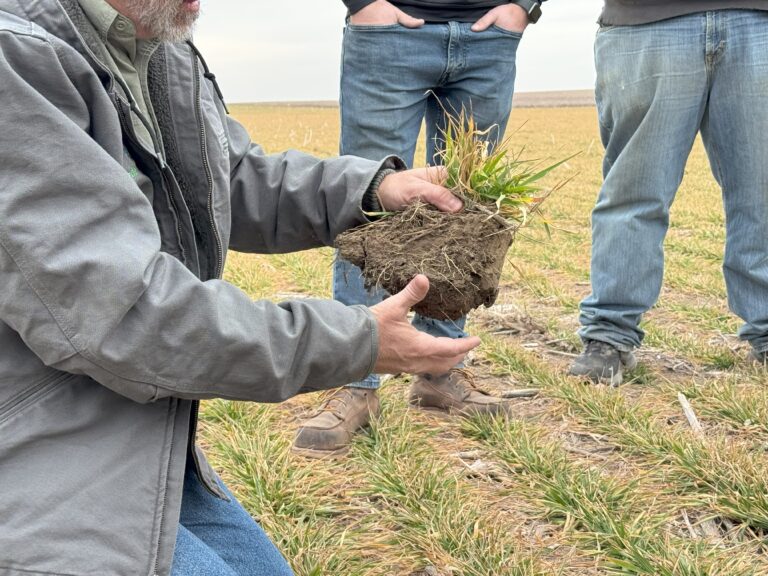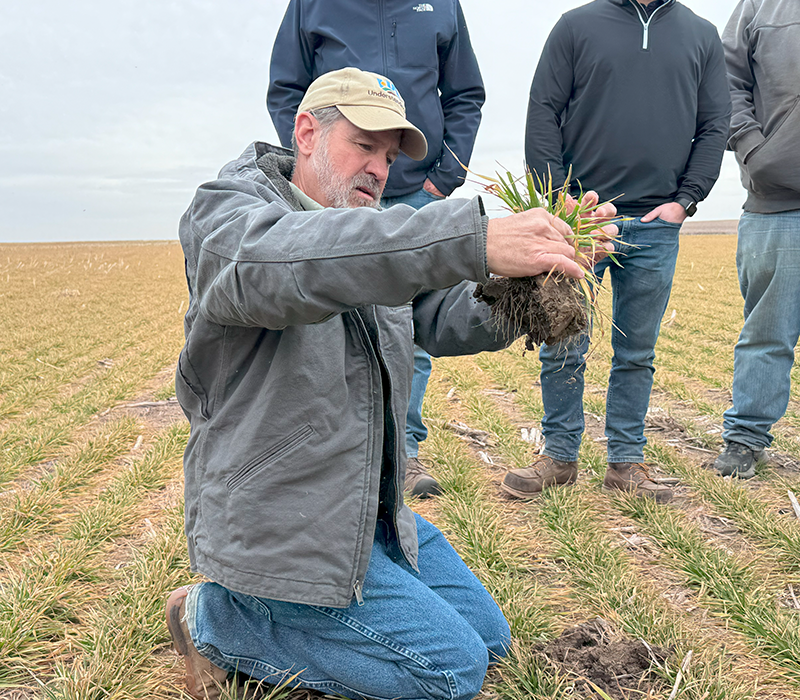Regenerative Agriculture Benefits Entire Supply Chain


Beth Stebbins
Director of Sustainability
May 9, 2025
Scoular launched its first regenerative agriculture pilot project in November 2023. What would happen, we asked, if we offered payments to farmers who use regenerative agriculture practices?”
We collaborated with both our growers and our flour milling customers to answer this question, ensuring the program’s value for everyone. We launched with three goals:
- Evaluate growers’ reception to our program framework.
- Enroll 10,000 acres.
- Source lower carbon-footprint grain
We achieved and, in some cases, exceeded these goals, based on results from year one. The pilot program benefited both ends of the supply chain: Farmers were rewarded for adopting regen ag practices, and the program helped to lower the carbon footprint of Scoular and its customers.
Grower Flexibility
Growers delivering wheat to Scoular facilities near Adrian, Missouri, and Coolidge, Kansas, and corn to Fremont, Nebraska, could participate. They selected regenerative agriculture practices from a list provided by Scoular. Each practice had an associated payment, with the highest payments tied to practices with the most potential for carbon sequestration. Producers could adapt the program to their farm system and goals, as farmers know their operations better than anybody else. Growers highlighted this freedom as one of their favorite parts of the program, and we learned that flexibility is essential.

Acre Enrollment
Our goal for the 2024 crop was 10,000 acres enrolled. However, our final enrollment well exceeded that, with over 16,000 acres from 29 growers. We credit that to farmers’ passion for the project. We found that we had a grower base eager to participate in regenerative projects through their grain buyer.
“It was a simple enrollment process,” said Jason Ochs, a Kansas farmer. Along with wheat, he grows sorghum, corn, camelina, sunflowers and canola. “We have been using regen practices and knew this program though Scoular would help us to do even more.”
Ochs said the program also helped him to understand that tillage is needed occasionally to repair washes or tumble grass that can’t be killed with chemicals. He and the other farmers implemented a variety of regenerative practices, outlined below:
| Acres Enrolled/Regen Farming Practice | On-farm Impact |
9,000 acres of no-till
| Reducing or eliminating tillage helps improve soil organic matter, which contributes to overall soil health by reducing nutrient leaching, improving water infiltration, and increasing resistance to erosion, among many other benefits.[1] |
| 2,400 acres of reduced tillage | |
| 2,400 acres of cover crops | Cover crops protect soil from erosion and provide root exudates in the soil, which promote the health of the soil microbiome. They offer additional benefits depending on the species:
|
| 11,700 acres using nutrient management practices | Nutrient management practices reduce fertilizer costs by helping farmers apply nutrients more efficiently. These practices also reduce the risk of nutrient runoff, reducing water pollution.[3] |
| 5,900 acres using integrated grazing | Grazing animals add manure to the soil, which increases organic matter and microbial activity, increasing overall soil health. This also reduces the need for synthetic nitrogen, leading to cost savings.[4] |
| 13,300 acres with extended crop rotation | A diverse crop rotation reduces the risk of disease and improves soil health by balancing nutrient uptake and replenishment. This can lead to improved crop yields.[5] |
Greenhouse Gas Emissions
As we had hoped, these practices resulted in reduced greenhouse gas emissions for our project acres. Through modeling, we can show the average emission factors for bushels enrolled in our program versus the emission factor for the project counties.
Project Geography | Project emissions factor (kgCO2e/bu) | Baseline emissions factor (kgCO2e/bu) | Difference (kgCO2e/bu) |
Adrian (wheat) | -2.9 | 4.76 | 7.66 |
Coolidge (wheat) | 5.40 | 21.76 | 16.36 |
Fremont (corn) | -11.70 | 0.74 | 12.44 |
The negative net emissions for the Adrian and Fremont projects show that on average, project fields were sequestering carbon, rather than emitting it.
Minnesota-based Miller Milling partnered with Scoular on the project.
“Miller Milling believes regenerative practices are critical to ensuring the continuity of wheat agriculture well into the future as well as to producing flour for our customers,” said Bella Morreale, the company’s ESG specialist. “Working with Scoular has allowed us to support regenerative practices, connect growers with our end users, and drive meaningful environmental and social impact in our supply chain.”
Still, she said, there is much to learn in the rapidly expanding space of regenerative agriculture.
“Scoular is a partner who provides exceptional technical support and knowledge, which helps facilitate our advancement in the regenerative ag space,” she added.
Our goal is to work with more end-use customers like Miller Milling to impact more acres and continue building a resilient supply chain.
Learn more about how we can help you to achieve your responsible sourcing goals. Email bstebbins@scoular.com
* Emission factors are calculated by summing on-field emissions minus the change in soil carbon stocks. Thus, they do not represent a full life cycle assessment of the grain being purchased, as factors such as emissions from fertilizer production are left out. However, these emission factors are great for use as a comparison tool.

